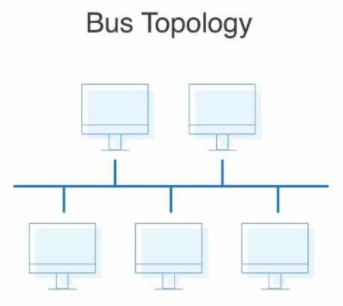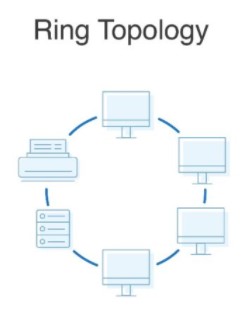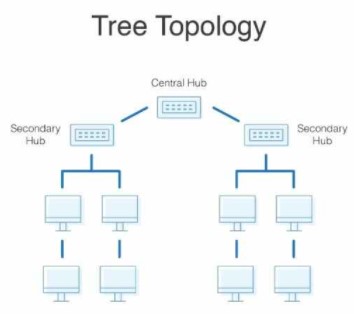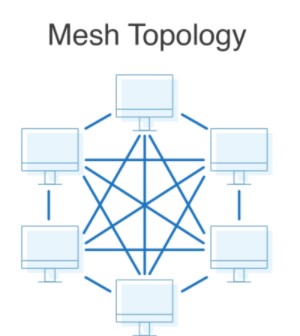Types of Network Topology
What is Topology
Topology defines the structure of the network of how all the components are interconnected to each other. There are two types of topology: physical and logical topology.
Star Topology
A star topology, the most common network topology, is laid out so every node in the network is directly connected to one central hub via coaxial, twisted-pair, or fiber-optic cable.

Advantages of Star Topology
Star topologies are common since they allow you to conveniently manage your entire network from a single location. Because each of the nodes is independently connected to the central hub,
Disadvantages of Star Topology
If the central hub goes down, the rest of the network can’t function and overall bandwidth and performance of the network are also limited,
Bus Topology
A bus topology orients all the devices on a network along a single cable running in a single direction from one end of the network to the other—which is why it’s sometimes called a “line topology” or “backbone topology.” Data flow on the network also follows the route of the cable, moving in one direction.

Advantages of Bus Topology
Bus topologies are a good, cost-effective choice for smaller networks because the layout is simple, allowing all devices to be connected via a single coaxial or RJ45 cable. If needed, more nodes can be easily added to the network by joining additional cables.
Disadvantages of Bus Topology
Bus topologies use a single cable to transmit data, they’re somewhat vulnerable. If the cable experiences a failure, the whole network goes down, which can be time-consuming and expensive to restore,
Ring Topology
Ring topology is where nodes are arranged in a circle (or ring). The data can travel through the ring network in either one direction or both directions, with each device having exactly two neighbors.

Advantages of Ring topology:
-
Network Management: Faulty devices can be removed from the network without bringing the network down.
-
Cost: Twisted pair cabling is inexpensive and easily available. Therefore, the installation cost is very low.
Disadvantages of Ring topology:
- Difficult troubleshooting: It requires specialized test equipment to determine the cable faults. If any fault occurs in the cable, then it would disrupt the communication for all the nodes.
- Failure: The breakdown in one station leads to the failure of the overall network.
Tree topology
Tree topology combines the characteristics of bus topology and star topology. The top-most node in tree topology is known as a root node, and all other nodes are the descendants of the root node.

Advantages of Tree topology
- Support for broadband transmission: Tree topology is mainly used to provide broadband transmission, i.e., signals are sent over long distances without being attenuated.
- Easily expandable: We can add the new device to the existing network. Therefore, we can say that tree topology is easily expandable.
Disadvantages of Tree topology
- Difficult troubleshooting: If any fault occurs in the node, then it becomes difficult to troubleshoot the problem.
- High cost: Devices required for broadband transmission are very costly.
Mesh topology.
Mesh technology is an arrangement of the network in which computers are interconnected with each other through various redundant connections. There are multiple paths from one computer to another computer. It does not contain the switch, hub or any central computer which acts as a central point of communication. The Internet is an example of the mesh topology.

Mesh topology is divided into two categories:
- Full Mesh Topology: In a full mesh topology, each computer is connected to all the computers available in the network.
- Partial Mesh Topology: In a partial mesh topology, not all but certain computers are connected to those computers with which they communicate frequently.
Advantages of Mesh topology:
- Reliable: The mesh topology networks are very reliable as if any link breakdown will not affect the communication between connected computers.
- Fast Communication: Communication is very fast between the nodes.
- Easier Reconfiguration: Adding new devices would not disrupt the communication between other devices.
Disadvantages of Mesh topology
- Cost: A mesh topology contains a large number of connected devices such as a router and more transmission media than other topologies.
- Management: Mesh topology networks are very large and very difficult to maintain and manage. If the network is not monitored carefully, then the communication link failure goes undetected.
- Efficiency: In this topology, redundant connections are high that reduces the efficiency of the network.
Hybrid Topology
The combination of various different topologies is known as Hybrid topology. A Hybrid topology is a connection between different links and nodes to transfer the data. Hybrid structures are most commonly found in larger companies where individual departments have personalized network topologies adapted.

Advantages of Hybrid Topology
The main advantage of hybrid structures is the degree of flexibility they provide, as there are few limitations on the network structure itself that a hybrid setup can’t accommodate.
Disadvantages of Hybrid Topology
However, each type of network topology comes with its own disadvantages, and as a network grows in complexity, so too does the experience and know-how required on the part of the admins to keep everything functioning optimally. There’s also the monetary cost to consider when creating a hybrid network topology.











